 W
WLightning is a naturally occurring electrostatic discharge during which two electrically charged regions in the atmosphere or ground temporarily equalize themselves, causing the instantaneous release of as much as one gigajoule of energy. This discharge may produce a wide range of electromagnetic radiation, from very hot plasma created by the rapid movement of electrons to brilliant flashes of visible light in the form of black-body radiation. Lightning causes thunder, a sound from the shock wave which develops as gases in the vicinity of the discharge experience a sudden increase in pressure. Lightning occurs commonly during thunderstorms and other types of energetic weather systems, but volcanic lightning can also occur during volcanic eruptions.
 W
WAct of God is a 2009 Canadian documentary film that investigates the "metaphysical" effects of being struck by lightning. It was directed by Jennifer Baichwal and distributed by Zeitgeist Films. The film's world premier was at the 2009 Hot Docs Canadian International Documentary Festival at the Royal Ontario Museum in Toronto on 30 April 2009. It went on general release in Canada on 1 May 2009, and limited release in the United States on 31 July 2009. The film's European premiere was at the 44th Karlovy Vary International Film Festival in the Czech Republic on 11 July 2009.
 W
WAstraphobia, also known as astrapophobia, brontophobia, keraunophobia, or tonitrophobia is an abnormal fear of thunder and lightning or an unwarranted fear of scattered and/or isolated thunderstorms, a type of specific phobia. It is a treatable phobia that both humans and animals can develop. The term astraphobia is composed of the Greek words ἀστραπή and φόβος.
 W
WBall lightning is an unexplained phenomenon described as luminescent, spherical objects that vary from pea-sized to several meters in diameter. Though usually associated with thunderstorms, the phenomenon is said to last considerably longer than the split-second flash of a lightning bolt. Some 19th-century reports describe balls that eventually explode and leave behind an odor of sulfur. Descriptions of ball lightning appear in a variety of accounts over the centuries and have received much attention from scientists. An optical spectrum of what appears to have been a ball-lightning event was published in January 2014 and included a video at high frame rate. Laboratory experiments have produced effects that are visually similar to reports of ball lightning, but how these relate to the supposed phenomenon remains unclear.
 W
WIn ancient Roman religion, a Bidental was a sacred spot erected on the location where lightning had struck. Any remains and scorched earth were to be burned in a hole at the location by priests called bidentales. Any person killed was to be buried in the earth where the lightning hit, as opposed to traditional cremation. A puteal (wellhead), or sometimes more than one, was then placed on the spot of burned earth. In order to further consecrate the spot, the head officiator would sacrifice a two-year-old sheep. Finally, an altar was built, surrounded by a wall or fence to keep any trespassers away. Considered sacred, it was not to be touched, tread on, or even looked at after completion. Occasionally when falling into a state of decay, Bidentals would be repaired or reconstructed.
 W
WCatatumbo lightning is an atmospheric phenomenon which occurs over the mouth of the Catatumbo River where it empties into Lake Maracaibo in Venezuela. It originates from a mass of storm clouds at a height of more than 1 km, and occurs during 140 to 160 nights a year, 10 hours per day and up to 280 times per hour. It occurs over and around Lake Maracaibo, typically over a bog area formed where the Catatumbo River flows into the lake.
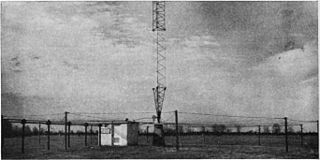 W
WIn electronics and radio communication a counterpoise is a network of suspended horizontal wires or cables, used as a substitute for an earth (ground) connection in a radio antenna system. It is used with radio transmitters or receivers when a normal earth ground cannot be used because of high soil resistance or when an antenna is mounted above ground level, for example, on a building. It usually consists of a single wire or network of horizontal wires, parallel to the ground, suspended above the ground under the antenna, connected to the receiver or transmitter's "ground" wire. The counterpoise functions as one plate of a large capacitor, with the conductive layers of the earth acting as the other plate.
 W
WThe distribution of lightning, or the incidence of individual strikes, in any particular place is highly variable, but lightning does have an underlying spatial distribution. High quality lightning data has only recently become available, but the data indicates that lightning occurs on average 44 times every second over the entire Earth, making a total of about 1.4 billion flashes per year.
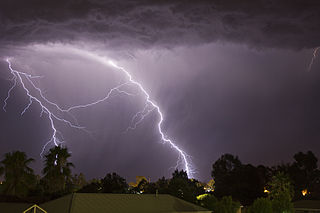 W
WA dry thunderstorm is a thunderstorm that produces thunder and lightning, but most or all of its precipitation evaporates before reaching the ground. Dry lightning refers to lightning strikes occurring in this situation. Both are so common in the American West that they are sometimes used interchangeably. The latter term is a technical misnomer since lightning itself is neither wet nor dry.
 W
WFulgurites are natural tubes, clumps, or masses of sintered, vitrified, and/or fused soil, sand, rock, organic debris and other sediments that sometimes form when lightning discharges into ground. Fulgurites are classified as a variety of the mineraloid lechatelierite. When ordinary negative polarity cloud-ground lightning discharges into a grounding substrate, greater than 100 million volts of potential difference may be bridged. Such current may propagate into silica-rich quartzose sand, mixed soil, clay, or other sediments, rapidly vaporizing and melting resistant materials within such a common dissipation regime. This results in the formation of generally hollow and/or vesicular, branching assemblages of glassy tubes, crusts, and clumped masses. Fulgurites have no fixed composition because their chemical composition is determined by the physical and chemical properties of whatever material is being struck by lightning.
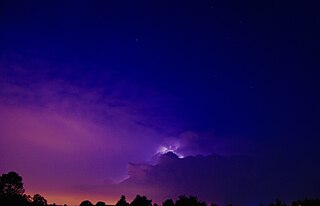 W
WHeat lightning, also known as silent lightning, summer lightning, or dry lightning, is a misnomer used for the faint flashes of lightning on the horizon or other clouds from distant thunderstorms that do not appear to have accompanying sounds of thunder.
 W
WThe kite experiment is a scientific experiment in which a kite with a pointed, conductive wire attached to its apex is flown near thunder clouds to collect electricity from the air and conduct it down the wet kite string to the ground. It was proposed and may have been conducted by Benjamin Franklin with the assistance of his son William Franklin. The experiment's purpose was to uncover the unknown facts about the nature of lightning and electricity, and with further experiments on the ground, to demonstrate that lightning and electricity were the result of the same phenomenon.
 W
WA Lichtenberg figure, or Lichtenberg dust figure, is a branching electric discharge that sometimes appears on the surface or in the interior of insulating materials. Lichtenberg figures are often associated with the progressive deterioration of high voltage components and equipment. The study of planar Lichtenberg figures along insulating surfaces and 3D electrical trees within insulating materials often provides engineers with valuable insights for improving the long-term reliability of high-voltage equipment. Lichtenberg figures are now known to occur on or within solids, liquids, and gases during electrical breakdown.
 W
WA lightning arrester is a device used on electric power systems and telecommunication systems to protect the insulation and conductors of the system from the damaging effects of lightning. The typical lightning arrester has a high-voltage terminal and a ground terminal. When a lightning surge travels along the power line to the arrester, the current from the surge is diverted through the arrester, in most cases to earth.
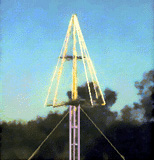 W
WA lightning detector is a device that detects lightning produced by thunderstorms. There are three primary types of detectors: ground-based systems using multiple antennas, mobile systems using a direction and a sense antenna in the same location, and space-based systems.
 W
WA lightning rod or lightning conductor (UK) is a metal rod mounted on a structure and intended to protect the structure from a lightning strike. If lightning hits the structure, it will preferentially strike the rod and be conducted to ground through a wire, instead of passing through the structure, where it could start a fire or cause electrocution. Lightning rods are also called finials, air terminals, or strike termination devices.
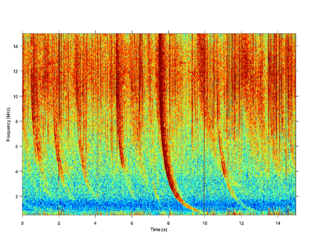 W
WA radio atmospheric signal or sferic is a broadband electromagnetic impulse that occurs as a result of natural atmospheric lightning discharges. Sferics may propagate from their lightning source without major attenuation in the Earth–ionosphere waveguide, and can be received thousands of kilometres from their source. On a time-domain plot, a sferic may appear as a single high-amplitude spike in the time-domain data. On a spectrogram, a sferic appears as a vertical stripe that may extend from a few kHz to several tens of kHz, depending on atmospheric conditions.
 W
WA relativistic runaway electron avalanche (RREA) is an avalanche growth of a population of relativistic electrons driven through a material by an electric field. RREA has been hypothesized to be related to lightning initiation, terrestrial gamma-ray flashes, sprite lightning, and spark development. RREA is unique as it can occur at electric fields an order of magnitude lower than the dielectric strength of the material.
 W
WSprites or red sprites are large-scale electrical discharges that occur high above thunderstorm clouds, or cumulonimbus, giving rise to a quite varied range of visual shapes flickering in the night sky. They are usually triggered by the discharges of positive lightning between an underlying thundercloud and the ground.
 W
WA thunderstorm, also known as an electrical storm or a lightning storm, is a storm characterized by the presence of lightning and its acoustic effect on the Earth's atmosphere, known as thunder. Relatively weak thunderstorms are sometimes called thundershowers. Thunderstorms occur in a type of cloud known as a cumulonimbus. They are usually accompanied by strong winds, and often produce heavy rain and sometimes snow, sleet, or hail, but some thunderstorms produce little precipitation or no precipitation at all. Thunderstorms may line up in a series or become a rainband, known as a squall line. Strong or severe thunderstorms include some of the most dangerous weather phenomena, including large hail, strong winds, and tornadoes. Some of the most persistent severe thunderstorms, known as supercells, rotate as do cyclones. While most thunderstorms move with the mean wind flow through the layer of the troposphere that they occupy, vertical wind shear sometimes causes a deviation in their course at a right angle to the wind shear direction.
 W
WStorm Data and Unusual Weather Phenomena (SD) is a monthly NOAA publication with comprehensive listings and detailed summaries of severe weather occurrences in the United States. Included is information on tornadoes, high wind events, hail, lightning, floods and flash floods, tropical cyclones (hurricanes), ice storms, snow, extreme temperatures such as heat waves and cold waves, droughts, and wildfires. Photographs of weather and attendant damage are used as much as possible. Maps of significant weather are also included.
 W
WThunder is the sound caused by lightning. Depending on the distance from and nature of the lightning, it can range from a sharp, loud crack to a long, low rumble (brontide). The sudden increase in pressure and temperature from lightning produces rapid expansion of the air within and surrounding the path of a lightning strike. In turn, this expansion of air creates a sonic shock wave, often referred to as a "thunderclap" or "peal of thunder". The study of thunder is known as brontology.
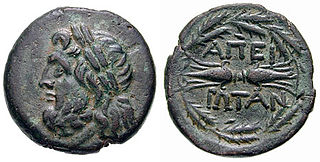 W
WA thunderbolt or lightning bolt is a symbolic representation of lightning when accompanied by a loud thunderclap. In Indo-European mythology, the thunderbolt was identified with the 'Sky Father'; this association is also found in later Hellenic representations of Zeus and Vedic descriptions of the vajra wielded by the god Indra. It may have been a symbol of cosmic order, as expressed in the fragment from Heraclitus describing "the Thunderbolt that steers the course of all things".
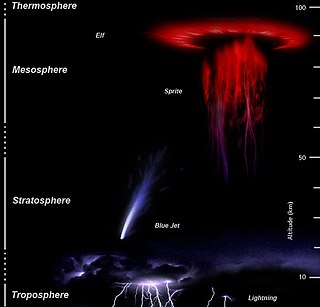 W
WUpper-atmospheric lightning or ionospheric lightning are terms sometimes used by researchers to refer to a family of short-lived electrical-breakdown phenomena that occur well above the altitudes of normal lightning and storm clouds. Upper-atmospheric lightning is believed to be electrically induced forms of luminous plasma. The preferred usage is transient luminous event (TLE), because the various types of electrical-discharge phenomena in the upper atmosphere lack several characteristics of the more familiar tropospheric lightning.
 W
WVolcanic lightning is an electrical discharge caused by a volcanic eruption, rather than from an ordinary thunderstorm. Volcanic lightning arises from colliding, fragmenting particles of volcanic ash, which generate static electricity within the volcanic plume, leading to the name dirty thunderstorm. Moist convection and ice formation also drive the eruption plume dynamics and can trigger volcanic lightning. But unlike ordinary thunderstorms, volcanic lightning can also occur before any ice crystals have formed in the ash cloud.
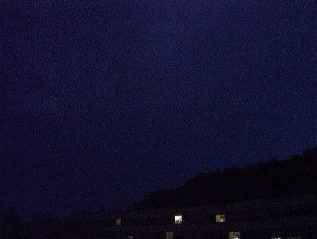 W
W